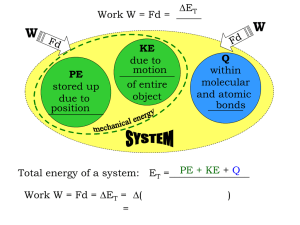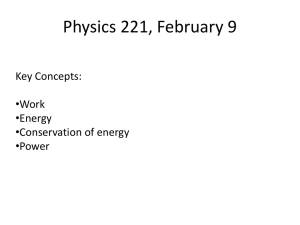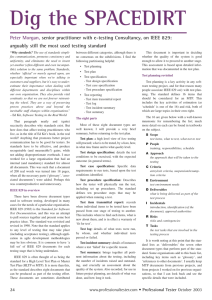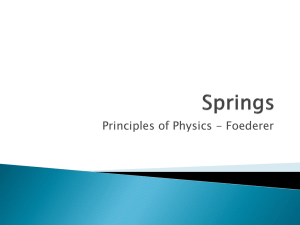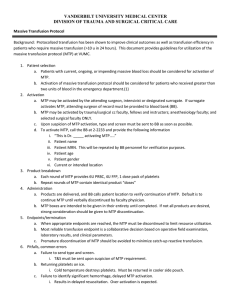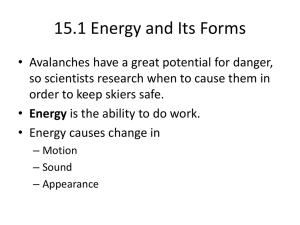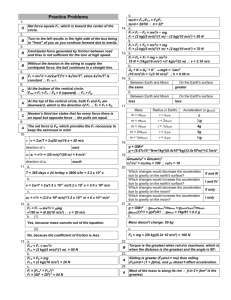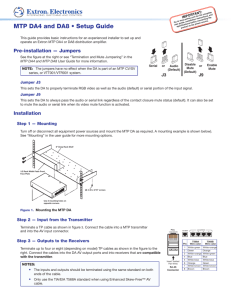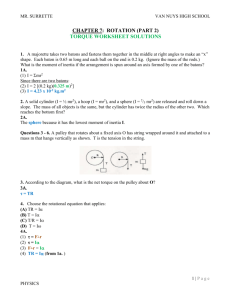F(x)
advertisement
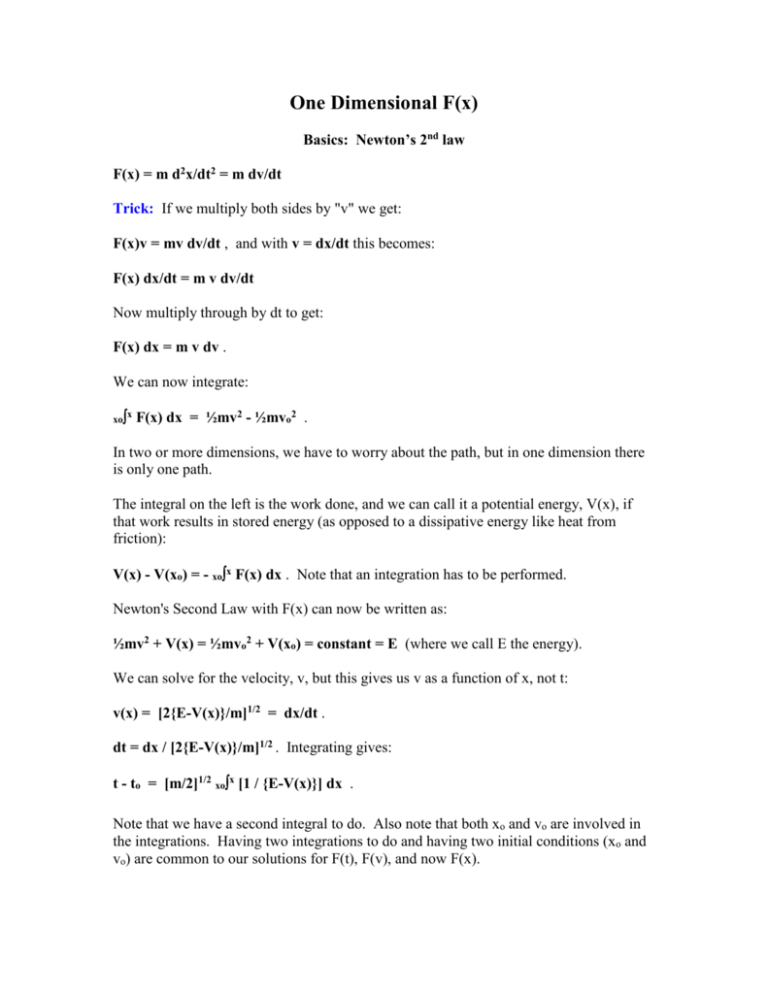
One Dimensional F(x)
Basics: Newton’s 2nd law
F(x) = m d2x/dt2 = m dv/dt
Trick: If we multiply both sides by "v" we get:
F(x)v = mv dv/dt , and with v = dx/dt this becomes:
F(x) dx/dt = m v dv/dt
Now multiply through by dt to get:
F(x) dx = m v dv .
We can now integrate:
x
xo
F(x) dx = ½mv2 - ½mvo2 .
In two or more dimensions, we have to worry about the path, but in one dimension there
is only one path.
The integral on the left is the work done, and we can call it a potential energy, V(x), if
that work results in stored energy (as opposed to a dissipative energy like heat from
friction):
V(x) - V(xo) = - xox F(x) dx . Note that an integration has to be performed.
Newton's Second Law with F(x) can now be written as:
½mv2 + V(x) = ½mvo2 + V(xo) = constant = E (where we call E the energy).
We can solve for the velocity, v, but this gives us v as a function of x, not t:
v(x) = [2{E-V(x)}/m]1/2 = dx/dt .
dt = dx / [2{E-V(x)}/m]1/2 . Integrating gives:
t - to = [m/2]1/2 xox [1 / {E-V(x)}] dx .
Note that we have a second integral to do. Also note that both xo and vo are involved in
the integrations. Having two integrations to do and having two initial conditions (xo and
vo) are common to our solutions for F(t), F(v), and now F(x).
Assuming we can do both integrals, we then get t(x) rather than x(t). To get the final x(t),
we need to be able to invert t(x) to get x(t). This may or may not be easy to do.
Homework Problem: Problem #7: Find x(t) and v(t) for a particle of mass, m, projected
up from the earth’s surface with the escape speed for the earth. Neglect air resistance.
Potential Energy and F(x)
If we choose some standard position, we can define a potential energy function:
V(x) - V(xs) = - xsx F(x) dx
By adding and then subtracting V(xs) to our energy equation, we get:
V(x) - V(xs) + V(xs) - V(xo) = ½mv2 - ½mvo2 = [V(x) - V(xs)] - [V(xo) - V(xs)] .
From the above it is easy to see that the xs position really doesn't matter at all. This is
why PE = mgh can be used as long as we pick some "nice" position to be h=0. It can be
the ground, it can be the floor, or the desk top. It really doesn't matter - as long as we
consistently measure h from the same position throughout the problem.
Now by having a definite V(x), we can plot V(x) versus x. We see from the equation:
½mv2 + V(x) = ½mvo2 + V(xo) = constant = E , or ½mv2 + V(x) = E
that since the kinetic energy, ½mv2 , is always positive, that the only allowed positions
are those positions that have V(x) less than (under) the value of E. Any point on the V(x)
plot that crosses the E=constant line will have v=0 at that position - hence this will be a
turning point of the motion. We will draw some V(x) curves in class and see what they
tell us about the motion.
Example: Harmonic Oscillator.
This is a nice example and an important one as we will shortly see.
F(x) = -kx (spring). From experience we know that a mass on a spring will oscillate, so
we might suspect that the solution for x(t) will involve a sine function.
If we started from Newton's Second Law directly, we would have:
-kx(t) = m d2x(t)/dt2
By our knowledge of functions, we could guess that x(t) = A sin(t + o) since the
second derivative of a sine function gives itself back again with a negative sign. And
since cosine also behaves this way, we might choose it. But including an initial phase
angle, o , we can take care of both possibilities.
But let's see how this works out analytically using the above energy procedure:
V(x) - V(xs) = - xsx (-kx) dx = ½ kx2 - ½ kxs2 .
If we let xs = 0, then V(xs) = 0 and V(x) = ½ kx2 .
From above, our next step is to do another integral to try and get t(x):
t
to=0
dt = xox dx / [2{E-V(x)}/m]1/2
t(x) = (m/2)1/2 xox dx / [E-½kx2]1/2
Now we take the E out of the []1/2 to get:
t(x) = (m/2E)1/2 xox dx / [1-½kx2/E]1/2
Now we set y2 = (k/2E)x2 which makes 2y dy = 2(k/2E)x dx , or
dx = 2y dy / [2(k/2E)x] = 2 (k/2E)1/2x dy / [(k/E)x] = (2E/k)1/2 dy so that
t(x) = (m/2E)1/2 xox dx / [1-½kx2/E]1/2
t(x) = (m/2E)1/2 (2E/k)1/2 yoy dy / [1-y2]1/2 = (m/k)1/2 yoy dy / [1-y2]1/2
where yo = [k/2E]1/2 xo and y = [k/2E]1/2 x .
Now we let y = sin() so that dy = cos() d we have:
t(x) = (m/k)1/2 o cos() d / [1-sin2()]1/2 = (m/k)1/2 o d = (m/k) ]o
where = sin-1(y) = sin-1([k/2E]1/2 x) . Thus we have:
t(x) = (m/k)1/2 sin-1([k/2E]1/2 x) - o . This can be inverted to give:
x(t) = A sin(t + o) where = (k/m)1/2 and A = [E/2k]1/2 .
This is the result we got above by our knowledge of functions.
Analysis:
As k increases, the frequency of the oscillation increases.
As m increases, the frequency of the oscillation decreases.
The amplitude depends on the energy (but as the square root of the energy - not linearly).



